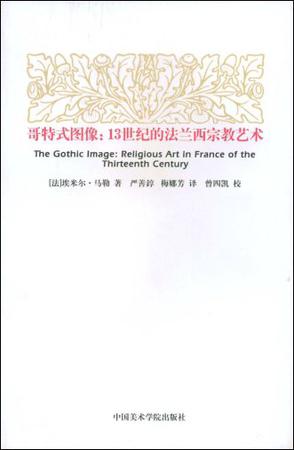-

哥特式图像
图像学在1984年通过《美术译丛》引入中国,当时范景中先生约请几位学者翻译了潘诺夫斯基和贡布里希的几篇著名论文,后来在1990年出版的《象征的图像》里,又系统介绍了图像学的理论、方法和成果。这引起了一些学者,特别是敦煌研究者的浓厚兴趣。 图像学在西方早已成为美术史的基础学科,也为人文学赢得了极大的光荣,即使是当今视觉文化潮流中的干将,也情愿打出新图像学的旗号,而不敢断然否决它。因此,图像学一直处在争论和改变当中。而它对中国美术史有何意义,则尤为我们所期待。现在上海师范美术学院打算以图像学为学科建设的重点,并以图像学的早期杰出学者马勒为介绍起点,这无疑是有益于学术界的一项重要工作。此文即简介马勒的图像学研究,希望能激起图者细读原著的兴趣。 -

Learning from Things
-

The Double Screen
Product Description In the first exploration of Chinese paintings as both material products and pictorial representations, The Double Screen shows how the collaboration and tension between material form and image gives life to a painting. A Chinese painting is often reduced to the image it bears; its material form is dismissed; its intimate connection with social activities and cultural conventions neglected. A screen occupies a space and divides it, supplies an ideal surface for painting, and has been a favorite pictorial image in Chinese art since antiquity. Wu Hung undertakes a comprehensive analysis of the screen, which can be an object, an art medium, a pictorial motif, or all three at once. With its diverse roles, the screen has provided Chinese painters with endless opportunities to reinvent their art. The Double Screen provides a powerful non-Western perspective on issues from portraiture and pictorial narrative to voyeurism, masquerade, and political rhetoric. It will be invaluable to anyone interested in the history of art and Asian studies. -

Landscape and Western Art
What is landscape? How does it differ from 'land'? Does landscape always imply something to be pictured, a scene? When and why did we begin to cherish images of nature? What is 'nature'? Is it everything that isn't art, or artefact? This book explores many fascinating issues raised by the great range of ideas and images of the natural world in Western art since the Renaissance. Using a thematic structure many issues are examined, for instance: landscape as a cultural construct; the relationship between landscape as accessory or backdrop and landscape as the chief subject; landscape as constituted by various practices of framing; the sublime and ideas of indeterminacy; landscape art as picturesque or as exploration of living processes. These issues are raised and explored in connection with Western cultural movements, and within a full international and historical context. Many forms of landscape art are included: painting, gardening, panorama, poetry, photography, and art. The book is designed to both take stock of recent interdisciplinary debates and act as a stimulus to rethinking our assumptions about landscape. -

Elegant Debts
-

The Oxford History of Western Art